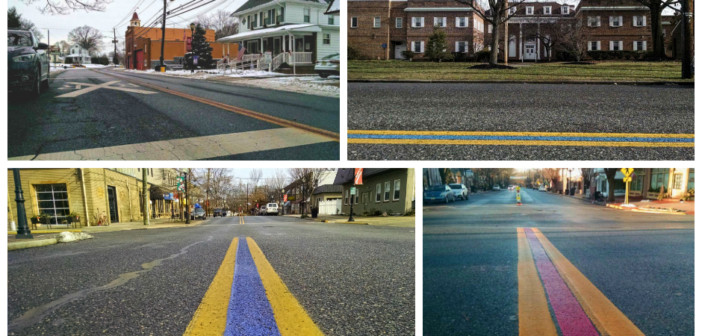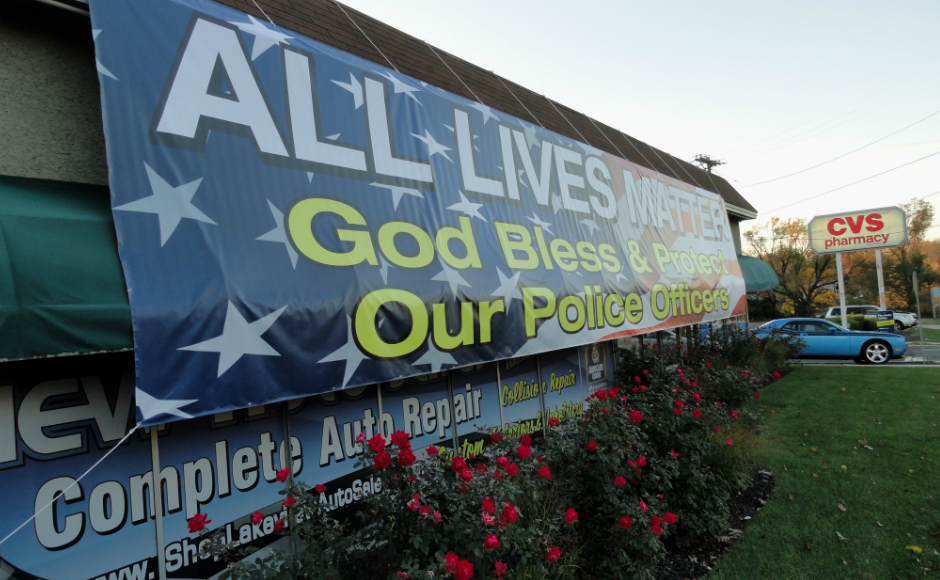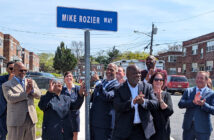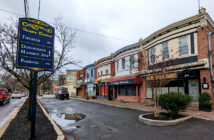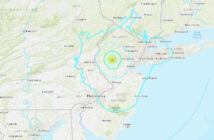Municipalities that have painted red or blue lines down the middle of their roadways in support of police and firefighters could subject themselves to legal liability for failing to conform to federal standard.
By Matt Skoufalos | January 11, 2017
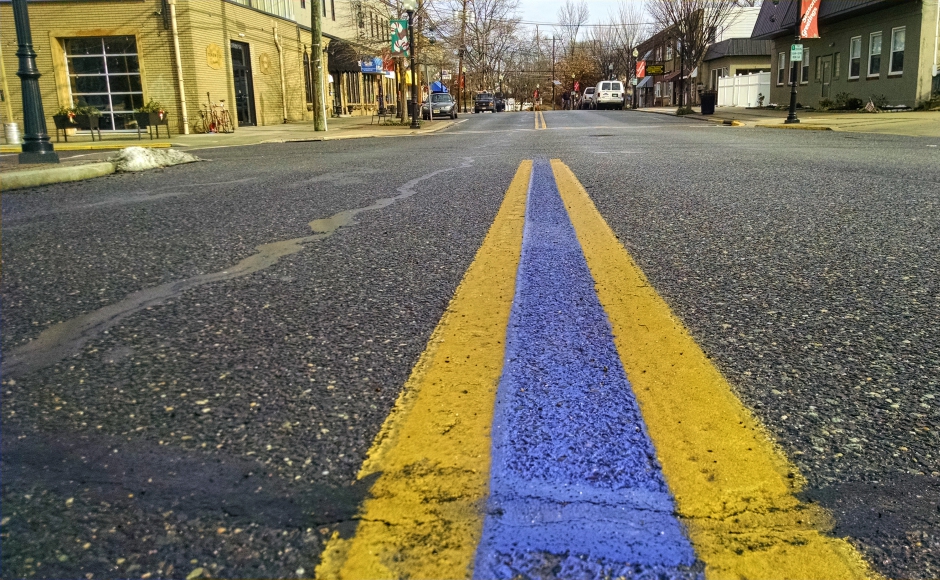
A blue line down West Clinton Avenue in Oaklyn denotes support for the local police department. Credit: Matt Skoufalos.
As the national political climate around law enforcement heated up in 2016, a number of South Jersey communities sought to demonstrate their support for their hometown first responders by adding a colored stripe to the center lines of local roadways: blue for law enforcement and red for firefighters.
But now the Federal Highway Administration (FHWA) is asking municipalities to conform to the established, double-yellow standard or else risk exposure to legal liability.
“We appreciate and understand the efforts by local governments and others that convey support for law enforcement officers,” FHWA spokesman Neil Gaffney said in a statement.
“However, the yellow lines down the center of a road are meant to control traffic, and modification of that marking could cause confusion, accidents and fatalities,” Gaffney wrote. “Our number one priority is the safety of all drivers.”
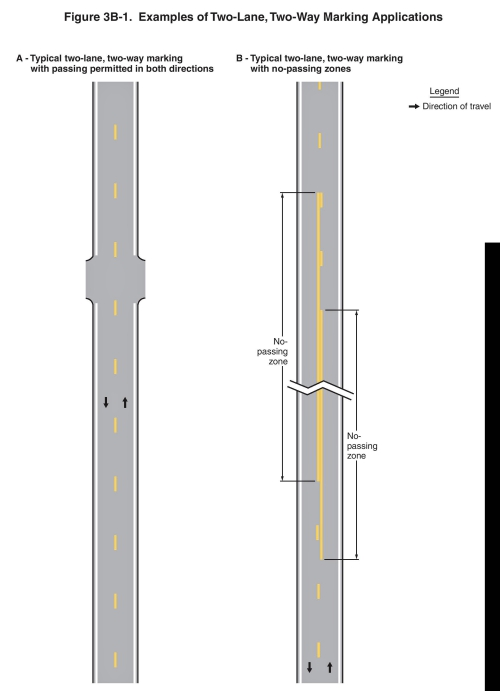
Standard highway markings according to the U.S. Manual on Uniform Traffic Control Devices. Credit: U.S. Federal Highway Administration.
The issue came to light in October, when Somerset County Engineer Matthew Loper wrote the FHA asking about whether the colored lines conform to the federal standard for public roadways.
In the Manual on Uniform Traffic Control Devices for Streets and Highways (MUTCD), a double line is indicated by “two parallel lines separated by a discernible space.”
Painting over the space between the lines is a problem, Gaffney explained, because it’s a nonstandard design that can create confusion for drivers and potentially contribute to a traffic accident.
Even if the colored lines don’t lead directly to an accident, a nonstandard stretch of roadway can expose the community to tort liability and the potential for a lawsuit.
Failure to comply could lead to a loss of federal aid, but since that aid is administered directly by state highway agencies and not locally, Gaffney said FHWA prefers to work with towns to bring them into compliance instead of penalizing them.
In a December 8, 2016 letter to Loper, FHWA Director of Transportation Operations Mark R. Kehrli said his office “appreciate[s]the impact of expressing support for law enforcement officers,” but added, “There are many appropriate and fitting ways to recognize service to the public that do not involve the modification of a traffic control device, which can put the road user at risk due to misinterpretation of its meaning.”
At least four Camden County communities had adopted the practice since the summer, adding either a blue or a red line, or both, to the double yellow lines amid some of their most highly traveled roadways.
In Haddon Heights, Police Captain Michael Scardino said the lines made him feel “like hometown America coming together,” fostering a deeper connection with the community at large while underscoring the small-town values of its residents.
“It wasn’t something that we asked for,” he said. “When it went there, we were deeply moved. It’s made us feel fantastic and appreciated, and it’s rejuvenated my officers. When you see a simple gesture for a cop, it means a lot. That blue line represents solidarity and support.”
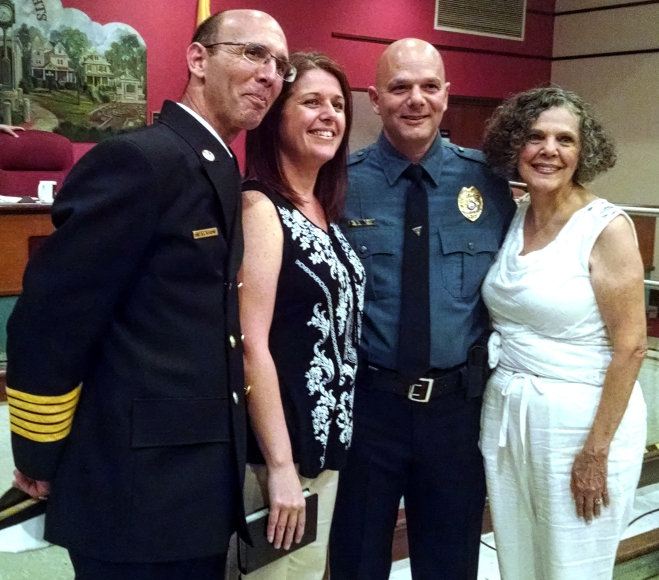
The Scardino family celebrates Michael Scardino’s promotion to Captain of the Haddon Heights PD. Credit: Matt Skoufalos.
Scardino, whose brother Nicholas is the borough fire chief, also said the red line that the Haddon Heights DPW added to the 600 block of Station Avenue has similarly invigorated both sets of first responders.
“I think it’s unique to see the red and the blue because the fire and police service work together,” Michael Scardino said.
“We always support each other,” he said.
“It just shows that we’re in this together, and that’s what Haddon Heights is all about.”
Whether the line remains, Oaklyn Police Chief Mark Moore said the paint job along West Clinton Avenue—which, he pointed out, was done in a different shade of blue than that used for handicap designations—reflects the unwavering support his department feels from the borough government and the community at large.
“Without any visible support, I know it’s always there,” Moore said. “Lately we’ve been getting a lot of support, I think even more than anybody in the area.”
In 2015, Lakeview Custom Coach owner Peter Corelli hung a gigantic banner outside his business to demonstrate his commitment to police. That effort coincided with a hit-and-run that injured Oaklyn Det. Jayne Jones outside the borough school, but was also a signifier of localized discussions around the Black Lives Matter movement.
Moore said such gestures acknowledge the risks inherent in policing at a time when officers have been violently ambushed and politically scrutinized.
“In the heat of what law enforcement’s experiencing right now [nationally], I think it was a very nice gesture of the town to do something for us,” Moore said.
“I hate to see it picked apart.”
Even in a small town that considers itself to be “a Mayberry,” said Oaklyn Mayor Robert Forbes, “we get some serious stuff.
“Every time somebody dies as a police officer, we see our Oaklyn police support it, but we try to do everything we can to make sure it doesn’t happen in town,” Forbes said.
The mayor doesn’t believe the “thin blue line support line is confusing motorists,” and said he hasn’t seen any traffic issues as a result of it. Forbes added that the borough will comply with any edict handed down from the state or federal government to repaint the roadway, and will work “to come up with another clever way to show support.”
In Audubon, where the West Merchant Street central business district has been adorned with both red and blue lines in support of the fire and police services, respectively, Mayor John Ward said the borough government had been hesitant to embrace the trend for fear of inviting regulatory action.
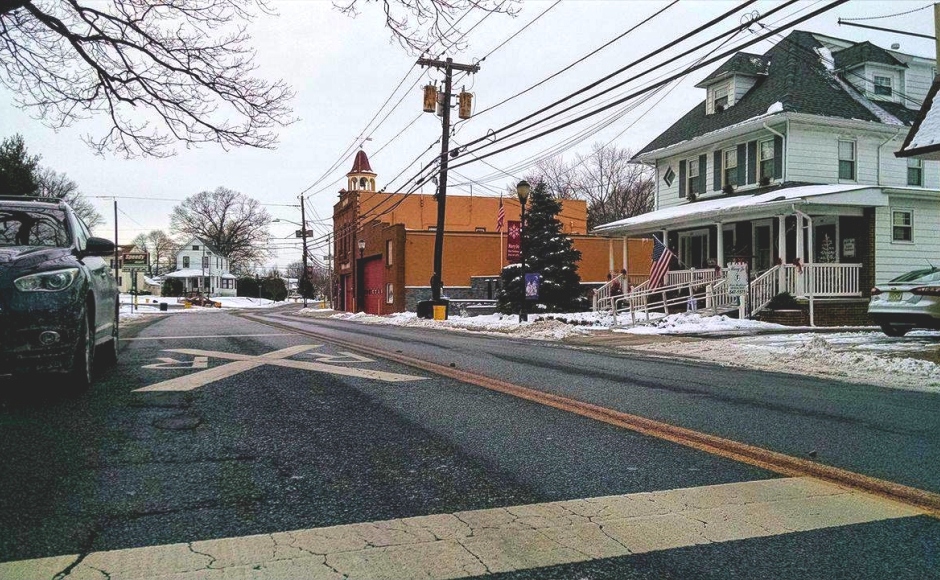
A red line down West Merchant Street in Audubon denotes support for the local fire department. Credit: Matt Skoufalos.
“When you mess with lines, somebody else will interpret that as an opportunity to sue,” Ward said.
“It’s latex [paint], so it’s going to wear away,” he said.
“If it’s still there after a year, we’ll probably paint over it with black.”
A similar tack is being taken in Cherry Hill, where Bridget Palmer, Director of Communications for Mayor Chuck Cahn, said a blue roadway stripe painted in front of the township municipal building would be allowed to fade with time.
“We just won’t repaint it, which I think is fair,” Palmer said, “and in the interim, we’ll start the discussion about whether there’s a more permanent solution; something we can do to honor the police department.”
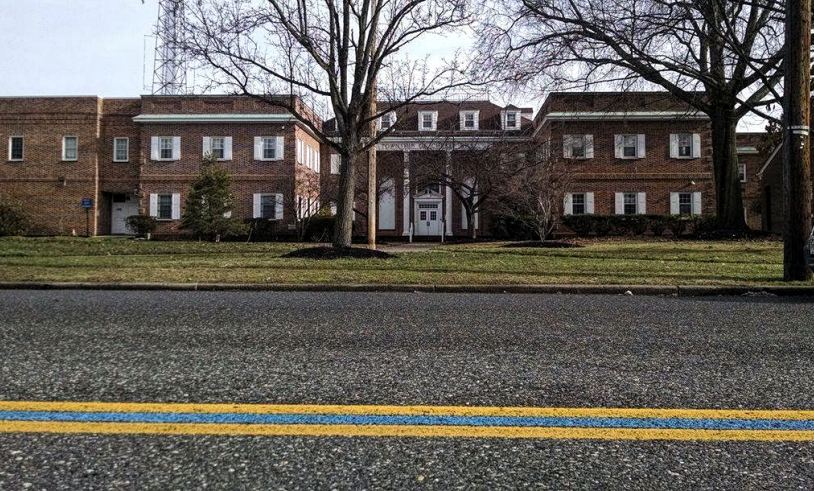
A blue line down Mercer Street in Cherry Hill denotes support for the local police department. Credit: Matt Skoufalos.
Cahn said the line is a valuable reminder of community support for the township police department, which is headquartered in the municipal building on Mercer Street, but the medium isn’t as important as the message.
“If it wasn’t a line, it would be a sign,” he said.
“I like the fact that our police department knows how much the community supports them.”
Cahn, Ward, and Forbes all said their administrations would seek alternative ways to demonstrate their support for first responders in their communities while keeping in compliance with the FHWA.
Get more local news that matters. Check out NJ Pen on Facebook and Twitter, or click here to become a supporter.

